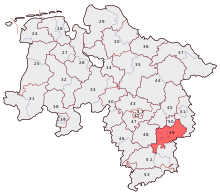Salzgitter – Wolfenbüttel
Salzgitter – Wolfenbüttel is one of the 299 single member constituencies used for the German parliament, the Bundestag. The constituency elects one representative under the mixed member proportional representation (MMP) system. Under the current constituency numbering system, it is designated as constituency 49.[1]
| 49 Salzgitter – Wolfenbüttel | |
|---|---|
| electoral district for the Bundestag | |
 | |
| State | Lower Saxony |
| Country | Germany |
| Current electoral district | |
| Created | 1949 |
| Party | SPD |
| Current Member | Sigmar Gabriel |
| Elected Year | 2017 |
| Most Successful Party | SPD (17 times) |
The constituency was created for the 1949 election, the first election in West Germany after World War II. Since 1961, the seat has been held by the SPD.
Overview
Located in Lower Saxony, the constituency consists of the northern part of the independent city of Salzgitter, district of Wolfenbüttel and the community cities of Langelsheim, Liebenburg, Seesen and Lutter am Barenberge, a Samtgemeinde from the Goslar (district).[2]
History
Upon creation for the 1949 election, the district was called Gandersheim – Salzgitter and covered the Salzgitter, Bad Gandersheim and Baddeckenstedt. The constituency was renamed Salzgitter – Wolfenbüttel for the 1980 election. Since then, the constituency name have remained unchanged.[3]
| Election | Constituency No. | Constituency Name |
|---|---|---|
| 1949 | 27 | Gandersheim – Salzgitter |
| 1953-61 | 49 | |
| 1965-76 | 44 | Salzgitter |
| 1980-98 | Salzgitter – Wolfenbüttel | |
| 2002-05 | 49 | |
| 2009 | 50 | |
| 2013 | 49 |
Members of the Bundestag
| Election | Member | Vote share % | Party | Source | Note | |
|---|---|---|---|---|---|---|
| 1949 | Karl Bielig | 35.2 | Social Democratic Party of Germany | [3] | 1st election after the division of the country | |
| 1953 | Wilhelm Höck | 39.8 | Christian Democratic Union of Germany | [3] | ||
| 1957 | 48.3 | [3] | ||||
| 1961 | Hans-Jürgen Junghans | 46.8 | Social Democratic Party of Germany | [3] | ||
| 1965 | 48.3 | [3] | ||||
| 1969 | 52.5 | [3] | ||||
| 1972 | 59.0 | [3] | ||||
| 1976 | 55.0 | [3] | ||||
| 1980 | 54.2 | [3] | ||||
| 1983 | 47.9 | [3] | ||||
| 1987 | Wilhelm Schmidt | 49.2 | [3] | |||
| 1990 | 45.4 | [3] | 1st election of the re-united Germany | |||
| 1994 | 49.9 | [3] | ||||
| 1998 | 58.9 | [3] | ||||
| 2002 | 56.8 | [3] | ||||
| 2005 | Sigmar Gabriel | 52.3 | [4] | |||
| 2009 | 46.6 | [5] | ||||
| 2013 | 46.6 | [6] | ||||
| 2017 | 42.8 | [7] | ||||
References
- Officer, The Federal Returning. "Results Salzgitter – Wolfenbüttel - The Federal Returning Officer". www.bundeswahlleiter.de. Retrieved 2018-02-07.
- Officer, The Federal Returning. "Delimitation of constituency boundaries Salzgitter – Wolfenbüttel - The Federal Returning Officer". www.bundeswahlleiter.de (in German). Retrieved 2018-02-07.
- Vierhaus, Rudolf (2002-01-01). Biographisches Handbuch der Mitglieder des Deutschen Bundestages 1949-2002 (in German). Walter de Gruyter. ISBN 9783110969054.
- "NIEDERSACHSEN BUNDESTAG ELECTIONS 2005 September 18 GERMANY ELECTIONS ARCHIVE". www.todor66.com. Retrieved 2018-02-04.
- "Endgültiges Ergebnis - Landeswahlleiter Niedersachsen" (PDF). landeswahlleiter.niedersachsen.de. Retrieved 2018-02-05.
- Officer, The Federal Returning. "Elected candidates by Land lists in Lower Saxony - The Federal Returning Officer". www.bundeswahlleiter.de. Retrieved 2018-02-04.
- Officer, The Federal Returning. "Elected candidates by Land lists in Niedersachsen - The Federal Returning Officer". www.bundeswahlleiter.de. Retrieved 2018-02-04.